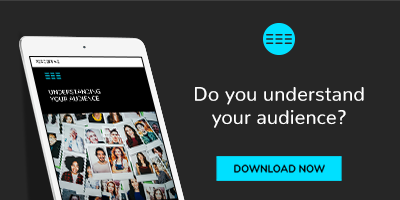Market research is an integral part of successful business, but it can be a significant investment for smaller businesses. Reduce your initial costs with this curated list of some of the best free market research tools available on the web.
Read more: Understanding your Audience, the complete guide to market research.
SurveyMonkey
SurveyMonkey is one of the most popular surveying tools available on the internet. It allows you to send out online surveys via email, links, website embeds and more. Question formats are highly flexible, including options for multiple choice, text boxes for longer answers, Likert scales and so on.
It has both free and premium plans, making it a good choice for businesses that want to dip their toes into research while still having the opportunity to upgrade later down the line.
Research type:✓ Qualitative ✓ Quantitative
|
Data type:✓ Demographic ✓ Geographic ✓ Psychographic ✓ Behavioural |
Pros: SurveyMonkey is a robust, flexible surveying tool that is simple to use and simple to deploy. It provides a lot of functionality even with its free plan too—there’s a good reason it’s popular.
Cons: If you are unsure of how to create accurate survey questions that are free of bias, you may have difficulty with SurveyMonkey. Despite SurveyMonkey's excellent set of tutorials on survey design, there is still a heavy reliance on your skillset as a user.
Further, while the free plan allows you to collect as many responses as you like, you can only view the first 100. That is not usually enough to create the robust market research you are looking for.
Social media insights
Facebook, Twitter, LinkedIn, Instagram and other social sites have built-in tools to provide you with information about your online presence, the performance of your adverts, and follower demographics and behaviour.
Outside of the tools, social media can also be used to gather views via comments left on your posts. Treat these as you would an open-ended question in an interview or survey.
HootSuite provides a particularly useful guide on how to access audience data for Twitter, LinkedIn and Facebook.
Research type:✓ Qualitative ✓ Quantitative
|
Data type:✓ Demographic ✓ Geographic ✓ Psychographic ✓ Behavioural |
Pros: Provides a wealth of data on your existing audience on how they behave online with your brand directly and with your competitors. It also offers the opportunity to research potential audiences by investigating competitor pages.
Cons: Depending on the size of your following and industry, there can be some limitations on social media insights. If your audience is large, drawing qualitative insights is a time-consuming, manual process. If the audience is small, there may not be enough data to draw valid conclusions. Social media generally provides a relatively surface-level view and it lacks the controlled qualitative data gathered by formal methods.
Google Analytics
Google Analytics tracks a wide variety of different metrics for your website, such as sessions, page views, dwell time and other page behaviour metrics . Essentially, it measures the performance of your site, giving you an idea of what kind of people visit your site, how many of them there are, how they get there and what they do once they’ve arrived.
It is a highly advanced tool that is considered a primary part of every research toolbox.
Research type:✓ Qualitative ✓ Quantitative
|
Data type:✓ Demographic ✓ Geographic ✓ Psychographic ✓ Behavioural |
Pros: Google Analytics gives you access to every type of data you can imagine, including the actual interest categories of your audience, based on their previous Google searches.
Cons: Depending on the privacy of your users, you may not have data available for the entirety of your audience. You cannot guarantee opt-in from every user. Further, it can take months before you start getting useful data: if your website has only been recently launched, then you may need to wait until you get more audience results.
Be careful of using Analytics data for analysing your entire audience as well: it only measures online behaviour, and only on your website. If there is a significant portion of your customers that doesn't visit the website, you will not capture their data.
Google Consumer Barometer
The Google Consumer Barometer is the result of a 2017 research project conducted by Google and its partners to investigate trends about internet uses, including purchasing decisions and behaviour, using surveys and interviews. It covers dozens of countries and tens of thousands of respondents.
This information has now been made accessible for free and includes a series of customisable graphs.
Research type:✓ Qualitative ✓ Quantitative
|
Data type:✓ Demographic ✓ Geographic ✖ Psychographic ✖ Behavioural |
Pros: This is a very robust study covering a lot of details about online consumer behaviour. The fact that it can be filtered by country, demographics, etc makes it a valuable resource for any business with an online presence.
Cons: For those businesses that primarily operate with brick-and-mortar stores, many of the insights won’t be all that useful. This is also data that isn’t specific to your company; it’s good for getting a general idea, or for getting more information on an audience you have already identified, but not useful for beginning your research.
Google Market Finder
Google Market Finder uses information about your business to find a recommended market somewhere around the world. This is presented as a ranked list, along with information about the country and its populace. It also provides high level data on demographics and buyer behaviour as well.
Research type:✖ Qualitative ✓ Quantitative
|
Data type:✓ Demographic ✓ Geographic ✖ Psychographic ✖ Behavioural |
Pros: If you are looking to expand your business into another country, the Google Market Finder provides an excellent starting point that only requires input from your website and some basic information about yourself.
Cons: The data is exceptionally high level, covering an entire country’s population. Your audience may be included, but so will all the people you aren’t interested in targeting. Further audience segmentation research is a must.
HubSpot (Free CRM)
HubSpot CRM is a customer relationship management tool that keeps track of your customers, their details and their interactions with your brand. Some of these interactions are automatically updated, while others must be input manually.
Research type:✓ Qualitative ✖ Quantitative
|
Data type:✓ Demographic ✓ Geographic ✓ Psychographic ✓ Behavioural |
Pros: HubSpot CRM keeps all of the information about a lead in one place, giving you deep qualitative data about their previous interactions with your brand. This makes it an excellent tool for formulating buyer personas and ultra-targeted campaigns.
Cons: It’s primarily a management tool rather than a data generation tool. It requires users to already have a strong customer base to draw from, as well as requiring users to keep the data updated manually.
Statista
Statista is a statistics amalgamation site with an enormous amount of data on every topic you could possibly think of—including research related to your audience. While a lot of this data is reserved for premium users, a significant portion is available for free.
Research type:✖ Qualitative ✓ Quantitative
|
Data type:✓ Demographic ✓ Geographic ✖ Psychographic ✖ Behavioural |
Pros: Statista has information on nearly any topic you could think of, from financial to demographic—though it is nearly purely quantitative data.
Cons: A lot of the best data is locked behind a paywall, and it only covers a select few countries. If you are based in New Zealand, you can find similar data from Statistics New Zealand, and Australia has the Australian Bureau of Statistics.
A word of caution
Free tools can be useful first steps but often lack the nuance you need to successfully undertake robust market research. Many of them lack psychographic profiling in particular, which is integral to ensuring you create offerings that appeal to people on a deeper level.
Even powerful tools require expertise to operate them, which is why many organisations instead turn to a market research company. They’ve got access to the latest research technology and have the expertise to use them effectively. While they may not be ‘free’, they are far more effective than the free alternatives—and considering how valuable market research is, it pays to ensure you have accurate, reliable data.
For more information on market research, download our all-in-one guide to understanding your audience.

